Station Name: BROCKHOLES
Still open but included for completeness
[Source:
Alan Young]
Brockholes Station Gallery 2: November 1956 - May 1978
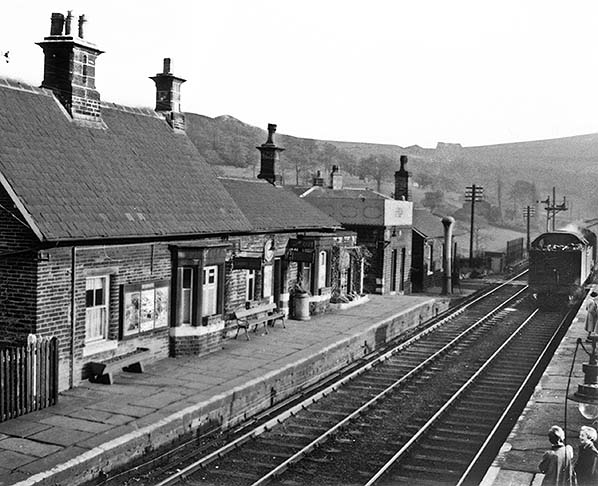 Looking east from the footbridge of Brockholes station on 3 November 1956, as a passenger train hauled bunker-first by a Fowler 4MT 2-6-4T enters the down platform to collect the waiting passengers, perhaps on their way to the shops in Huddersfield on this Saturday. The station building, constructed of small, coursed blocks of sandstone, is seen on the up platform. Although the building is of two storeys, only the lower one faces the platform, and it is provided with a canted bay window allowing the stationmaster a good view of his domain. The steeply-pitched, slated roof is followed by a less steep roof of similar construction above the single-storey wing, also possessing a bay window. The water tank on its stone base can be seen at the platform ramp, accompanied by the water crane, and a stone-built goods office/store is beyond. The station is neat and tidy and was one of many to win awards in the annual ‘Best Kept Station’ awards presented by BR North Eastern Region.
Photo by JCW Halliday
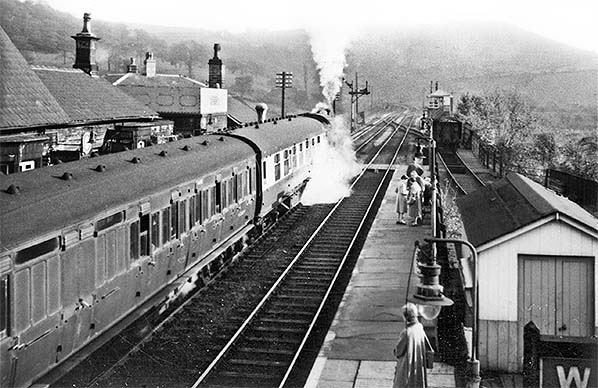
Looking south-east from the footbridge of Brockholes station on 3 November 1956. A steam-hauled passenger train bound either for Penistone or Clayton West, as indicated by the left splitting signal in the ‘off’ position, is standing at the up platform in front of the main buildings. The passengers gathered on the down platform suggest that a Huddersfield-bound train will soon arrive. A single coal wagon is seen on the siding to the right. The signal box seen in the distance, beyond the wagon, is close to the junction where the Holmfirth Branch swings away from the main line.
Photo by JCW Halliday
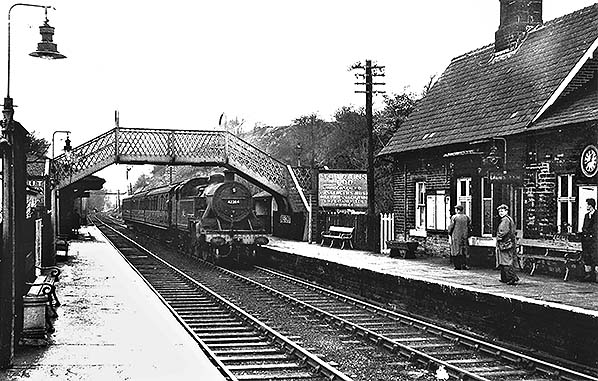
Brockholes station looking north-west c1950s. A passenger train is about to stop at the up platform at 12.40pm to collect some passengers. If this is a mid 1950s picture, if the clock is correct, and if the train is more-or-less on time, it is most likely a Saturday-only working to Holmfirth or Clayton West! The main station building and wing, with their soot-stained sandstone, are seen to the right. The gas lamps are prominent in this view, as are the footbridge and the unnecessarily large sign telling passengers for Huddersfield to use it. The loco is Fowler-designed Class 4P-D 2-6-4T No.42384, built in July 1932 at Derby. Its number in LMS days was 2384. The loco had the distinction in March 1956 of running away at Skelmanthorpe (on the nearby Clayton West Branch) and demolishing three empty stock coaches. She was withdrawn on 10 August 1963 from 25B, Huddersfield shed, and cut up at Derby
the following December.
Photo
from John Mann collection
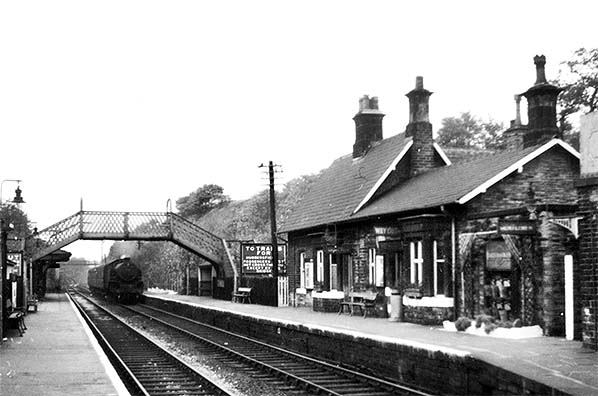
On Friday 17 October 1958 a short steam-hauled passenger train, probably for Clayton West or Penistone is entering Brockholes station. The train is a 3-car ex-LMS set hauled by what appears to be either a Stanier or Fairburn 4MT 2-6-4. This is a charming study of a quiet country junction station, preserving its Victorian atmosphere albeit without the throng of passengers that would await most trains in those earlier days. The main station building and its wing (right) are constructed of sandstone beneath pitched stone roofs. Although the main building apparently possesses only one storey when seen from the track-side, from this angle it can be seen that it has an upper storey, whose pitched roof is visible beyond the wing. On the far side of the footbridge a smaller building, also of stone, is on the down platform. An LMS ‘Hawkesye’ nameboard is seen on the right. The unsubtly large LYR sign on the up platform advises passengers for Huddersfield to cross the footbridge.
Photo by JCW Halliday
Even in these soggy conditions (which occur frequently in the Pennines!) Brockholes station looks appealing, not least because of the reflections off the irregular flagstones and the apparently rural setting. No date is available for this photo, but it is probably from the 1950s/60s. The single-storey south-east wing of the main building is seen in the foreground on the up platform, with its canted bay thrusting forward onto the platform. Beyond the footbridge, a hipped-roofed stone building is seen, and a timber shed is closer, beyond the platform fence. Prominent fixtures are the gas lamps and the particularly large sign instructing passengers on the down platform wishing to leave the station to cross the footbridge (rather than use the barrow crossing).
Photo
by Ben Brooksbank
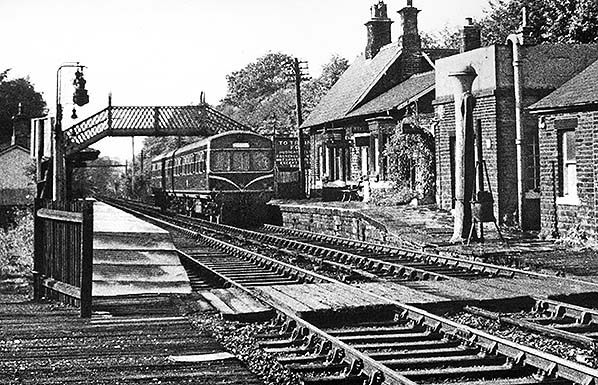
By summer 1964, when this photograph was taken at Brockholes, the Holmfirth Branch, which began at this station, had already closed to passengers. The threat of closure now hung over Brockholes and the Huddersfield – Penistone line as it was named in the ‘Beeching Report’ of March 1963. In late 1959 DMUs had been introduced to the route, and a Metro Cammell set, with ‘whiskers’ beneath the cab, is entering the station’s up platform. Brockholes still possesses its full range of buildings and the staff keep the station in good order. However there has been little official investment in a station seen as dispensable, with fixtures and fittings all dating from LMS or LYR days. This monochrome photograph does not indicate whether the signs have been repainted in BR North Eastern tangerine, but they probably have been ‘freshened up’ in this modern livery.
Photo
by FJ Bullock
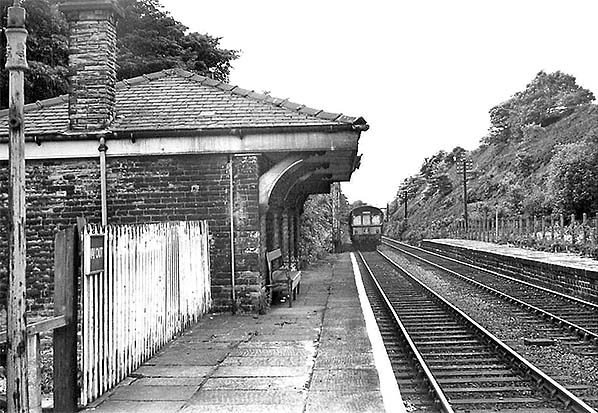
Looking north-west from the down platform of Brockholes station in June 1969 as a Metro Cammell DMU leaves the station en route to Huddersfield. By this time the threat of closure has been lifted, although it would return some years later. Brockholes and the other intermediate stations between Huddersfield and Penistone ceased to be staffed from 15 August 1966 and the service was operated as what would soon be known as a ‘Paytrain’ on which tickets were issued by the train conductor/guard. The down platform building is seen here, carefully constructed of small, coursed sandstone blocks, but blackened by many decades of smoke pollution. The station is lit by gas and would continue to be until the mid 1970s.
photo from John Mann collection
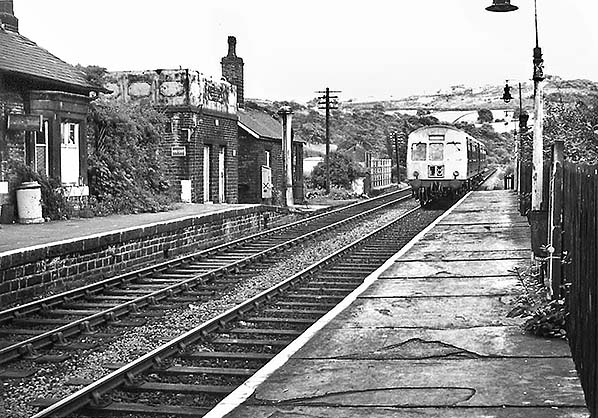
In June 1969 a Huddersfield-bound DMU is entering Brockholes station. On the left (up) platform are the single-storey wing of the main building, the water tank on its stone base and a stone-built goods office/store. The water crane column is still in position although redundant. Gas lighting is still in use and, although not apparent in this view, LMS ‘Hawkseye’ nameboards are understood still to have been in place. By this date the station has been unstaffed for almost three years but it is still in reasonable order; many stations were swiftly disfigured by vandals once they ceased to have staff in attendance, but the station building here remained in residential use which probably served as a deterrent to anyone considering causing damage.
photo from John Mann collection
The up platform of Brockholes station is seen from a passing train on 2 August 1970. Although unstaffed since 1966 the main building has been retained, in residential use, and it remains so at the time of writing (May 2016). The building seen here is in two distinct sections, both constructed of coursed thin blocks of sandstone. The further section has a taller, steeper pitched roof, and is a two-storey building although only the lower storey (with canted bay) is presented to the platform; the closer section is a single-storey wing, also with a canted bay. The station is still gas-lit, one ‘Sugg’ type lamp being suspended from the pipe attached to the building. Close to this lamp, the bracket to which an earlier ‘casement’ lantern was attached is still in place.
Photo
by Dr. Richard Gulliver
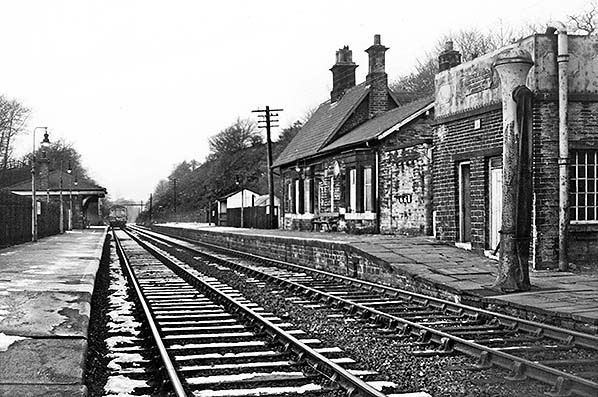
Brockholes station looking north-west from the down platform ramp c1970. Apart from the removal of the footbridge (and of the staff!) this view essentially differs little from those of previous decades. The station retains its buildings and gas lamps, but British Rail ‘Corporate Identity’ has made an inconspicuous arrival, with a running-in nameboard on the fence to the left, and LYR and LMS signage has been removed. A DMU is departing for Huddersfield.
Photo
by John Mann
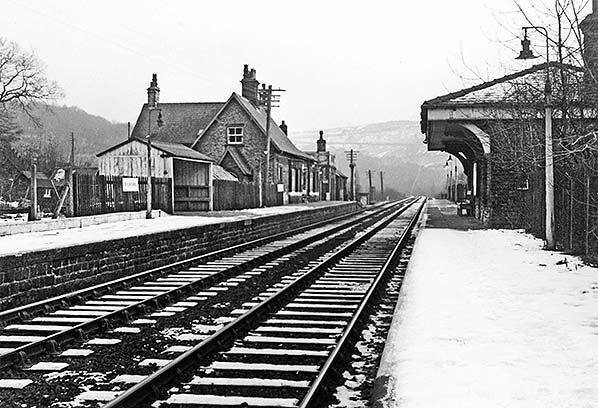
Brockholes station may be unstaffed in this c1970 south-eastward view, but someone has cleared snow from parts of the platforms. At this time the future of the Huddersfield – Sheffield train service and the station seem secure, and British Rail has given grounds for this optimism by removing LYR and LMS signage and fitting a modern ‘Corporate Identity’ nameboard to the fence on the up platform (left). The footbridge connecting the platforms has been removed; as tickets are sold on the trains there is no longer any need for northbound passengers to buy a ticket in the office on the up platform then cross to the down platform for their train. The station retains its Victorian buildings on both platforms and is lit by gas. The waiting shed, ahead on the down platform, would soon be removed in favour
of a simpler structure.
Photo
by John Mann

On 12 August 1974 Brockholes station is seen from a Huddersfield-bound train. The two-storey, sandstone-built station house is shown clearly here, with its steeply-gabled porch complementing the steep pitch of the slate roof. Earlier photographs show only a single-storey platform elevation, but a dormer of a crude design has recently been added above the more elegant bay window. The single-storey wing is seen beyond, and further away is the stone-built goods office/store. The water tank and its stone base have been removed. The unusual juxtaposing of an elderly gas lamp and a modern British Rail ‘Corporate Identity’ nameboard will be noted. Other stations on the line also displayed this strange feature for several years
Photo
by Alan Young
A general view of Brockholes station looking south-east in May 1978. The antiquated, rural charm of the station has been lost thanks to the arrival of tall, vandal-proof lamp standards which dwarf everything else; they were installed by British Rail (Eastern Region) at many of its stations in northern England in the 1970s. More discreet BR ‘Corporate identity’ nameboards are in place. The station house abutting the up platform is still in residential use, its platform frontage marred by a rather nasty flat-roofed dormer. The timber barrow store on that platform has been retained, but the stone building on the down platform has given way to a much smaller waiting shelter. This photo was taken from a Huddersfield-bound train in the days when it was possible, in railway enthusiasts’ parlance, to ‘window-hang’.
Photo
by Alan Young
Click here for Brockholes Station Gallery 2:
Spring 1984 - February 2016
| Last
updated: Sunday, 04-Jun-2017 10:02:12 CEST |
© 1998-2016 Disused Stations
| |

